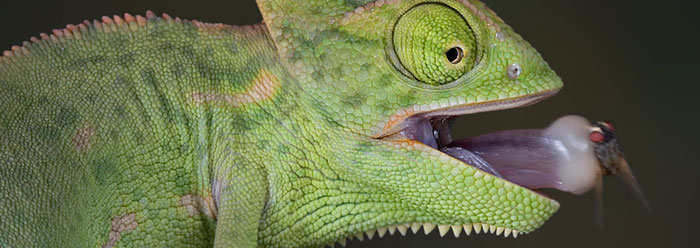The chameleon is a special lizard with a unique mode of hunting—a projectile tongue that can extend twice its body length to latch on to prey. Although this creature's spring-loaded feeding mechanism has been studied for years, the details of how it works have only recently come to light. Now, experts are studying its mechanisms to find new ways to improve the manipulative capabilities of robots.
In a study published in the journal Bioinspiration & Biomimetics,1 engineer Alexis Debray made four robotic structures, each mimicking features of the chameleon tongue. Depending on what apparatus is mounted on the tip end, robotic projectiles like these could be used to accomplish tasks such as picking or stamping items on an assembly line.
In describing the chameleon's tongue and support structures, collectively called the "hyolingual apparatus," Debray inadvertently illustrated why this biological system must have been created with all of its interdependent features fully formed.
The chameleon's tongue is anchored to its body with precisely fitted bones. One of them is pen-shaped and also serves as a directional support, like the stabilizing bar on a model rocket launch pad. Without this bone, the tongue would have no support for the spring-loading muscle to work against, and the lizard would have no control over the direction in which it aims its tongue.
The spring-loading or "accelerator" muscle can be adjusted to various tensions according to the required distance to the target. When released, the tip of the tongue flies under its own inertia, making this one of the rare and wonderful examples of projectiles in the animal kingdom. But without an opposing mechanism to reel the tongue back in, how would the chameleon ingest its captured meal? Fortunately, the tongue is equipped with a long and flexible retraction muscle.
Even with these opposing muscle sets, connective tissues, and bone anchors, the chameleon's hyolingual apparatus would have no use at all unless the chameleon also had eyes to see the prey, a brain to both process the visual data and send motor stimuli to the appropriate tongue muscles, and nerves to carry the information to and from the appropriate places in the chameleon's body.
The hyolingual apparatus is clearly an all-or-nothing biological system. And since it could not have acquired its precise features gradually, it could not have been built by anything but a detail-oriented Engineer.
Despite this, study author and robot inventor Debray said that the chameleon "evolved from the lepidosauria, also the ancestor of the snake, the skink, and the gecko, and developed many specializations not found in other reptiles. One of those specializations is a ballistic tongue."1
The term Lepidosauria refers to a group or classification of lizards—those with overlapping scales. No fossils show any hint of an evolutionary proto-lizard transitioning into snakes, skinks, geckos, or chameleons. Instead, each of these reptile kinds always appears in the fossil record already possessing its full set of obviously functional characteristics.2
If these creatures evolved from "the lepidosauria," then why is there not one candidate ancestor among the fossils, let alone the innumerable transitional forms that should be expected to have been fossilized at many points during millions of years of supposed evolutionary lizard history?
At least one evolutionary ancestor of the chameleon would not yet have evolved the entire tongue apparatus, and must therefore have had only some parts in place. But without the wide array of specialized and interdependent features all in place at the same time, such an imaginary creature would have starved. No ancestors would mean there should be no modern chameleons.
The amazing chameleon not only strongly testifies to the ingenuity of its Maker, but its highly specialized "ballistic tongue" also shoots down any evolutionary speculations about its origins.
References
- Debray, A. 2011. Manipulators inspired by the tongue of the chameleon. Bioinspiration & Biomimetics. 6: 026002.
- For example, see Thomas, B. Fossilized Gecko Fits Creation Model. ICR News. Posted on icr.org, September 8, 2008, accessed April 8, 2011.
* Mr. Thomas is Science Writer at the Institute for Creation Research.
